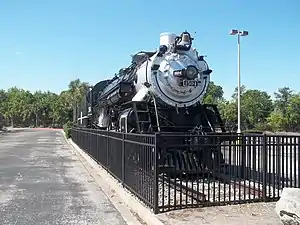Atlantic Coast Line class P-5-A
The Atlantic Coast Line P-5-A was a class of 70 4-6-2 USRA Light Pacific steam locomotives built by the American Locomotive Company's Richmond and Brooks Works between 1919 and 1920 for the Atlantic Coast Line Railroad (ACL) to haul their premier main line passenger trains. By the early 1950s, all of the P-5-As were retired and scrapped with exception of No. 1504, who survived into preservation and is currently undergoing restoration to operating condition.
| Atlantic Coast Line class P-5-A | |||||||||||||||||||||||||||||||||||||||||||||||||
|---|---|---|---|---|---|---|---|---|---|---|---|---|---|---|---|---|---|---|---|---|---|---|---|---|---|---|---|---|---|---|---|---|---|---|---|---|---|---|---|---|---|---|---|---|---|---|---|---|---|
 Atlantic Coast Line No. 1504 on static display in April 2018 | |||||||||||||||||||||||||||||||||||||||||||||||||
| |||||||||||||||||||||||||||||||||||||||||||||||||
| |||||||||||||||||||||||||||||||||||||||||||||||||
| |||||||||||||||||||||||||||||||||||||||||||||||||
| |||||||||||||||||||||||||||||||||||||||||||||||||
Service history
The locomotives pulled passenger trains 10 to 12 cars long, including the Miamian, the Florida Special, Palmetto Limited, the Southland, the South Wind and the Dixie Flyer. By the late 1940s, the railroad had dieselised its passenger trains and they were assigned to fast freight service, of which they were successful in doing so.[1][2][3] However, they could not pull passenger trains exceeding 14 cars without double-heading, as such, they were replaced in heavier passenger service by the R-1 class of Northerns.[4]
Preservation
Only one P-5-A has been preserved, No. 1504. It was chosen for preservation by ACL president Champion Davis and the Head of ACL's Mechanical Department, John W. Hawthornethe. In 1960, after some years in storage, the locomotive was given a thorough mechanical overhaul and then placed on display in front of the then new ACL General Office Building in Jacksonville.[5] It was cosmetically restored and put on display at the Prime F. Osborn III Convention Center, where it resided until 2021.[6] It is the only surviving original USRA Light Pacific steam locomotive and is in almost original condition.
The locomotive was designated as a National Historic Mechanical Engineering Landmark in 1990.[7] It is also on the National Register of Historic Places.
In 2021, No. 1504 was purchased by the U.S. Sugar Corporation and moved to the FMW Solutions' Southeastern Office and Fabrication Shop in Chattanooga, Tennessee,[8] where it is currently being restored to operating condition for the South Central Florida Express, Inc. in Clewiston, Florida.[9][10]
References
- https://www.rgusrail.com/flacl1504.html
- https://www.metrojacksonville.com/article/2008-oct-atlantic-coast-line-1504
- "Atlantic Coast Line 4-6-2 "Pacific" Locomotives in the USA".
- "Atlantic Coast Line 4-8-4 "Northern" Locomotives in the USA".
- https://www.metrojacksonville.com/article/2008-oct-atlantic-coast-line-1504
- https://www.rgusrail.com/flacl1504.html
- "Atlantic Coast Line Locomotive No. 1504, Jacksonville, Fla". National Railway Historical Society. Archived from the original on September 20, 2015. Retrieved April 18, 2019.
- Scanlan, Dan (August 24, 2021). "Jacksonville's ol' No. 1504 leaves the station en route to restoration". The Florida Times-Union. Archived from the original on August 25, 2021. Retrieved August 26, 2021.
- Marbut, Max (June 4, 2021). "City may transfer historic locomotive at Prime Osborn". Jacksonville Daily Record. Archived from the original on June 4, 2021. Retrieved June 5, 2021.
- "U.S. Sugar interested in acquiring second steam locomotive". Trains. Kalmbach Media. June 7, 2021. Archived from the original on June 7, 2021. Retrieved June 7, 2021.